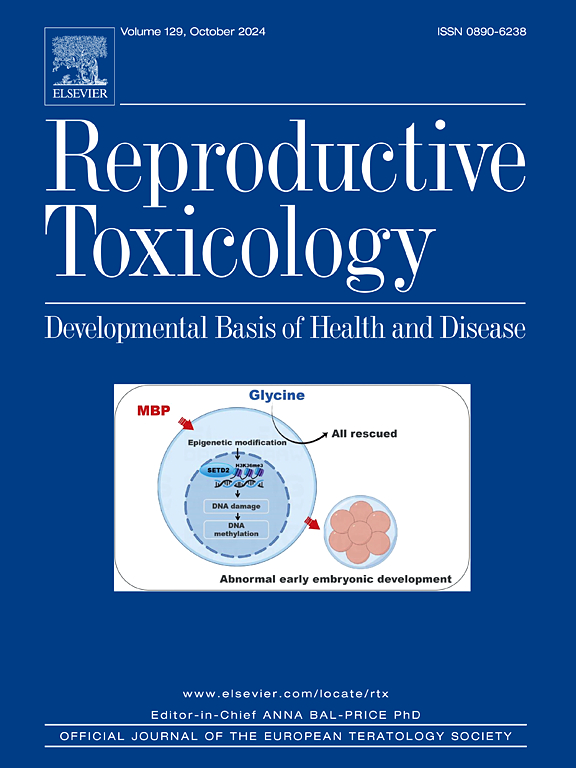Determination of the zebrafish embryo developmental toxicity assessment (ZEDTA) as an alternative non-mammalian approach for the safety assessment of agrochemicals
IF 3.3
4区 医学
Q2 REPRODUCTIVE BIOLOGY
引用次数: 0
Abstract
With the US Environment Protection Agency reducing requests for (and funding of) mammalian studies alongside the proposed elimination of requests by 2035, there is an urgent need for fully validated New Approach Methods (NAMs) to fill the resultant gap for safety assessment of agrochemicals. One promising NAM for assessing the potential for human prenatal developmental toxicity potential is the Zebrafish Embryo Developmental Toxicity Assessment, a bioassay that has been used by the pharmaceutical industry for more than a decade in early-stage drug safety assessment. Despite its promise, little data has been generated to assess the validity of ZEDTA for assessing Developmental and Reproductive Toxicity of new agrochemical products. Addressing this knowledge gap, we tested 67 compounds (insecticides, herbicides and fungicides) spanning multiple different chemical groupings and mechanisms of action. ZEDTA assay results were compared with the European Chemicals Agency (ECHA) Classification and Labelling (C&L) for mammalian hazard classification and with publicly available data to determine the ZEDTA’s translation power. Overall, the ZEDTA assay had an effective detection capability of 65 % for sensitivity and 64 % for specificity as compared with the ECHA-C&L classification and publicly available data. Comparing the ZEDTA data there were both strengths and weaknesses in alignments for across the different chemical classes and chemical mechanisms of action. Overall, the data generated, show the performance of the ZEDTA assay was comparable with other bioassays highlighted as alternatives for mammalian assessment and holds good promise as a NAM for screening agrochemical prenatal developmental toxicity during new product human safety assessment.
测定斑马鱼胚胎发育毒性评价(ZEDTA)作为农用化学品安全性评价的替代非哺乳动物方法。
随着美国环境保护署减少对哺乳动物研究的要求(和资助),并提议到2035年取消这些要求,迫切需要完全验证的新方法(NAMs)来填补农用化学品安全评估的空白。用于评估人类产前发育毒性潜力的一种有前途的不连续试验是斑马鱼胚胎发育毒性评估,这是一种生物测定法,已被制药行业用于早期药物安全性评估超过十年。尽管它很有希望,但很少有数据可以评估ZEDTA在评估新农用化学品的发育和生殖毒性方面的有效性。为了解决这一知识缺口,我们测试了67种化合物(杀虫剂、除草剂和杀菌剂),涵盖了多种不同的化学分类和作用机制。ZEDTA检测结果与欧洲化学品管理局(ECHA)哺乳动物危害分类和标签(C&L)进行比较,并与公开数据进行比较,以确定ZEDTA的翻译能力。总体而言,与ECHA-C&L分类和公开数据相比,ZEDTA检测的灵敏度为65%,特异性为64%。比较ZEDTA数据,在不同化学类别和化学作用机制的比对中既有优点也有缺点。总的来说,所产生的数据表明,ZEDTA测定法的性能可与其他生物测定法相媲美,这些生物测定法被强调为哺乳动物评估的替代方法,并且在新产品人类安全评估期间,作为筛选农用化学品产前发育毒性的NAM具有良好的前景。
本文章由计算机程序翻译,如有差异,请以英文原文为准。
求助全文
约1分钟内获得全文
求助全文
来源期刊

Reproductive toxicology
生物-毒理学
CiteScore
6.50
自引率
3.00%
发文量
131
审稿时长
45 days
期刊介绍:
Drawing from a large number of disciplines, Reproductive Toxicology publishes timely, original research on the influence of chemical and physical agents on reproduction. Written by and for obstetricians, pediatricians, embryologists, teratologists, geneticists, toxicologists, andrologists, and others interested in detecting potential reproductive hazards, the journal is a forum for communication among researchers and practitioners. Articles focus on the application of in vitro, animal and clinical research to the practice of clinical medicine.
All aspects of reproduction are within the scope of Reproductive Toxicology, including the formation and maturation of male and female gametes, sexual function, the events surrounding the fusion of gametes and the development of the fertilized ovum, nourishment and transport of the conceptus within the genital tract, implantation, embryogenesis, intrauterine growth, placentation and placental function, parturition, lactation and neonatal survival. Adverse reproductive effects in males will be considered as significant as adverse effects occurring in females. To provide a balanced presentation of approaches, equal emphasis will be given to clinical and animal or in vitro work. Typical end points that will be studied by contributors include infertility, sexual dysfunction, spontaneous abortion, malformations, abnormal histogenesis, stillbirth, intrauterine growth retardation, prematurity, behavioral abnormalities, and perinatal mortality.
 求助内容:
求助内容: 应助结果提醒方式:
应助结果提醒方式:


